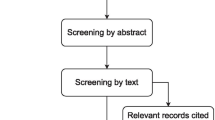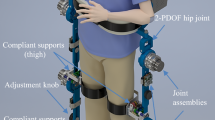Abstract
Effectively controlling active power-assist lower-limb exoskeletons in a human-in-the-loop manner poses a substantial challenge, demanding an approach that ensures wearer autonomy while seamlessly adapting to diverse wearer needs. This paper introduces a novel hierarchical control scheme comprising five integral components: intention recognition layer, dynamics feedforward layer, force distribution layer, feedback compensation layer, as well as sensors and actuators. The intention recognition layer predicts the wearer’s movement and enables wearer-dominant movement through integrated force and position sensors. The force distribution layer effectively resolves the statically indeterminate problem in the context of double-foot support, showcasing flexible control modes. The dynamics feedforward layer mitigates the effect of the exoskeleton itself on movement. Meanwhile, the feedback compensation layer provides reliable closed-loop control. This approach mitigates abrupt changes in joint torques during frequent transitions between swing and stance phases by decomposed dynamics. Validating this innovative hierarchical control scheme on a hydraulic exoskeleton platform through a series of experiments, the results demonstrate its capability to deliver assistance in various modes such as step**, squatting, and jum** while adapting seamlessly to different terrains.













Similar content being viewed by others
Data Availability Statement
The datasets generated and analyzed during the current study are not publicly available, as the data also forms part of an ongoing study but are available from the corresponding author on reasonable request.
References
Qiu, S., Pei, Z. C., Wang, C., & Tang, Z. Y. (2023). Systematic review on wearable lower extremity robotic exoskeletons for assisted locomotion. Journal of Bionic Engineering, 20(2), 436–469.
Tang, X. Y., Wang, X. P., Ji, X. M., Zhou, Y. W., Yang, J., Wei, Y. C., & Zhang, W. J. (2022). A wearable lower limb exoskeleton: Reducing the energy cost of human movement. Micromachines, 13(6), 900.
Deng, J., Wang, P. F., Li, M. T., Guo, W., Zha, F. S., & Wang, X. (2017). Structure design of active power-assist lower limb exoskeleton apal robot. Advances in Mechanical Engineering, 9(11), 168781401773579.
Kong, Y. K., Choi, K. H., Cho, M. U., Kim, S. Y., Kim, M. J., Shim, J. W., Park, S. S., Kim, K. R., Seo, M. T., Chae, H. S., & Shim, H. H. (2022). Ergonomic assessment of a lower-limb exoskeleton through electromyography and Anybody modeling system. International Journal of Environmental Research and Public Health, 19(13), 8088.
Lee, H., Ferguson, P. W., & Rosen, J. (2020). Lower limb exoskeleton systems—overview. Wearable Robotics (pp. 207–229). Elsevier.
Chen, W., Li, J., Zhu, S. Y., Zhang, X. D., Men, Y. T., & Wu, H. (2022). Gait recognition for lower limb exoskeletons based on interactive information fusion. Applied Bionics and Biomechanics. https://doi.org/10.1155/2022/9933018
Yeung, L. F. Ockenfeld, C., Pang, M. K., Wai, H. W., Soo, O. Y., Li, S. W., Tong, K. Y. (2017). Design of an exoskeleton ankle robot for robot-assisted gait training of stroke patients. IEEE Internation Conference on Rehabilitation Robotics, London, UK (pp. 211–215).
Orhan, Z. Ö., Shafiee, M., Juillard, V., Oliveira, J. C., Ijspeert, A., Bouri, M. (2023). ExoRecovery: Push recovery with a lower-limb exoskeleton based on step** strategy. ar**v preprint ar**v:2310.20339.
Chinmilli, P., Redkar, S., Zhang, W. L., & Sugar, T. (2017). A review on wearable inertial tracking based human gait analysis and control strategies of lower-limb exoskeletons. International Robotics & Automation Journal, 3(7), 398–415.
Li, M. T., Deng, J., Zha, F. S., Qiu, S. Y., Wang, X., & Chen, F. (2018). Towards online estimation of human joint muscular torque with a lower limb exoskeleton robot. Applied Sciences, 8(9), 1610. https://doi.org/10.3390/app8091610
Qian, Y. P., Wang, Y. N., Chen, C. H., **ong, J. F., Leng, Y. Q., Yu, H. Y., & Fu, C. L. (2022). Predictive locomotion mode recognition and accurate gait phase estimation for hip exoskeleton on various terrains. IEEE Robotics and Automation Letters, 7(3), 6439–6446.
Qian, Y. P., Wang, Y. N., Geng, H. L., Du, H., **ong, J. F., Leng, Y. Q., & Fu, C. L. (2023). Adaptive oscillator-based gait feature extraction method of hip exoskeleton for stroke patients. IEEE Transactions on Medical Robotics and Bionics. https://doi.org/10.1109/TMRB.2023.3329585
Choi, S., Ko, C., & Kong, K. (2023). Walking-speed-adaptive gait phase estimation for wearable robots. Sensors, 23(19), 8276. https://doi.org/10.3390/s23198276
Sun, Y. X., Tang, Y. T., Zheng, J., Dong, D. B., Chen, X. H., & Bai, L. (2022). From sensing to control of lower limb exoskeleton: A systematic review. Annual Reviews in Control, 53, 83–96.
Li, K. X., Zhang, J. H., Wang, L. F., Zhang, M. L., Li, J. Y., & Bao, S. C. (2020). A review of the key technologies for semg-based human-robot interaction systems. Biomedical Signal Processing and Control, 62(11), 102074. https://doi.org/10.1016/j.bspc.2020.102074
Asanza, V., Peláez, E., Loayza, F., Lorente-Leyva, L. L., & Peluffo-Ordóñez, D. H. (2022). Identification of lower-limb motor tasks via brain–computer interfaces: A topical overview. Sensors, 22(5), 2028. https://doi.org/10.3390/s22052028
Li, M. Y., Duan, S. C., Dong, Y., Wang, C., Feng, W., Wu, X. (2020). A hierarchical fusion strategy based on EEG and sEMG for human-exoskeleton system. In 2020 IEEE International Conference on Real-time Computing and Robotics (RCAR). Asahikawa, Japan, (pp. 458–463).
Tortora, S., Tonin, L., Chisari, C., Micera, S., & Artoni, F. (2020). Hybrid human-machine interface for gait decoding through bayesian fusion of EEG and EMG classifiers. Frontiers in Neurorobotics, 14, 582728. https://doi.org/10.3389/fnbot.2020.582728
Shi, K. C., Huang, R., Mu, F. J., Peng, Z. N., Huang, K., Qin, Y. Z., Yang, X. Cheng, H. (2022). A novel multimodal human-exoskeleton interface based on EEG and sEMG activity for rehabilitation training. In 2022 International Conference on Robotics and Automation (ICRA), Philadelphia, PA, USA (pp. 8076–8082).
Nasr, A., Hunter, J., Dickerson, C. R., & McPhee, J. (2023). Evaluation of a machine-learning-driven active–passive upper-limb exoskeleton robot: Experimental human-in-the-loop study. Wearable Technologies, 4, e13. https://doi.org/10.1017/wtc.2023.9
Masengo, G., Zhang, X. D., Dong, R. L., Alhassan, A. B., Hamza, K., & Mudaheranwa, E. (2023). Lower limb exoskeleton robot and its cooperative control: A review, trends, and challenges for future research. Frontiers in Neurorobotics, 16, 913748. https://doi.org/10.3389/fnbot.2022.913748
Wang, J. Q., Wu, D. M., Gao, Y. Z., Wang, X. R., Li, X. Q., Xu, G. Q., & Dong, W. (2022). Integral real-time locomotion mode recognition based on GA-CNN for lower limb exoskeleton. Journal of Bionic Engineering, 19(5), 1359–1373.
Liu, K. P., Li, L., Li, W. T., Gu, J., & Sun, Z. B. (2023). Compliant control of lower limb rehabilitation exoskeleton robot based on flexible transmission. Journal of Bionic Engineering, 20(3), 1021–1035.
Laubscher, C. A., Goo, A., Farris, R. J., & Sawicki, J. T. (2022). Hybrid impedance-sliding mode switching control of the indego explorer lower-limb exoskeleton in able-bodied walking. Journal of Intelligent & Robotic Systems, 104(4), 76. https://doi.org/10.1007/s10846-022-01583-7
Liu, L., Illian, M., Leonhardt, S., & Misgeld, B. (2023). Iterative learning control for cascaded impedance-controlled compliant exoskeleton with adaptive reaction to spasticity. IEEE Transactions on Instrumentation and Measurement., 72, 1–11.
Sun, Y. H., Peng, Z. N., Hu, J. P., & Ghosh, B. K. (2024). Event-triggered critic learning impedance control of lower limb exoskeleton robots in interactive environments. Neurocomputing, 564, 126963.
Yang, Y., Huang, D. Q., **, C. W., Liu, X., & Li, Y. N. (2023). Neural learning impedance control of lower limb rehabilitation exoskeleton with flexible joints in the presence of input constraints. International Journal of Robust and Nonlinear Control, 33(7), 4191–4209.
Nasr, A., Hashemi, A., & McPhee, J. (2022). Model-based mid-level regulation for assist-as-needed hierarchical control of wearable robots: A computational study of human-robot adaptation. Robotics, 11(1), 20. https://doi.org/10.3390/robotics11010020
Neilson, P. D., & Neilson, M. D. (2005). An overview of adaptive model theory: Solving the problems of redundancy, resources, and nonlinear interactions in human movement control. Journal of neural engineering, 2(3), S279. https://doi.org/10.1088/1741-2560/2/3/S10
Shi, Y. P., Li, M. T., Zha, F. S., Sun, L. N., Guo, W., Ma, C., & Li, Z. B. (2020). Force-controlled compensation scheme for P-Q valve-controlled asymmetric cylinder used on hydraulic quadruped robots. Journal of Bionic Engineering, 17(6), 1139–1151.
Acknowledgements
This work was supported by the China Postdoctoral Science Foundation (No. 2020M672823), National Natural Science Foundation of China National Natural Science Foundation of China (No. 52305072, U2013602), Natural Science Foundation of Hebei Province of China (No. E2022203095), Shenzhen Science and Technology Program (No. JSGG20201102152602007), Shenzhen Science and Technology Research and Development Foundation (No. JCYJ20190813171009236), and Basic Scientific Research of Technology (No. JCKY2020603C009).
Author information
Authors and Affiliations
Corresponding author
Ethics declarations
Conflict of Interest
The authors declare that they have no conflicts of interest relevant to the content of this article.
Additional information
Publisher's Note
Springer Nature remains neutral with regard to jurisdictional claims in published maps and institutional affiliations.
Rights and permissions
Springer Nature or its licensor (e.g. a society or other partner) holds exclusive rights to this article under a publishing agreement with the author(s) or other rightsholder(s); author self-archiving of the accepted manuscript version of this article is solely governed by the terms of such publishing agreement and applicable law.
About this article
Cite this article
Deng, J., Jiang, W., Gao, H. et al. A Hierarchical Control Scheme for Active Power-assist Lower-limb Exoskeletons. J Bionic Eng (2024). https://doi.org/10.1007/s42235-024-00561-z
Received:
Revised:
Accepted:
Published:
DOI: https://doi.org/10.1007/s42235-024-00561-z




